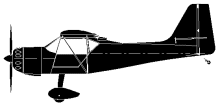
ASN Wikibase Occurrence # 200596
This information is added by users of ASN. Neither ASN nor the Flight Safety Foundation are responsible for the completeness or correctness of this information.
If you feel this information is incomplete or incorrect, you can submit corrected information.
| Date: | Saturday 20 August 2016 |
| Time: | 10:00 |
| Type: |  Denney Kitfox 4-1200 (Classic IV) |
| Owner/operator: | Private |
| Registration: | N51TM |
| MSN: | C9406-0031 |
| Year of manufacture: | 2000 |
| Total airframe hrs: | 551 hours |
| Engine model: | Jabiru 2200 |
| Fatalities: | Fatalities: 0 / Occupants: 1 |
| Aircraft damage: | Substantial |
| Category: | Accident |
| Location: | Canandaigua, NY -
 United States of America United States of America
|
| Phase: | Landing |
| Nature: | Private |
| Departure airport: | Weedsport, NY (B16) |
| Canandaigua, NY (D38) | |
| Investigating agency: | NTSB |
| Confidence Rating: |
The private pilot, who was also the owner/builder of the experimental, amateur-built, tailwheel-equipped airplane, was conducting a cross-country personal flight. He reported that, during landing, a rudder pedal torque tube separated, which resulted in a loss of directional control and the airplane departing the right side of the runway.
Metallurgical examination revealed that the vertical torque tube for the right rudder pedal had fractured at a fillet welded intersection where it attached to a horizontal torque tube. The fracture surface exhibited a small thumbnail-like fatigue region followed by an overstress region.
The pilot had assembled the airplane about 16 years before the accident, and it had accrued about 551 hours of operation. The actual kit model was manufactured 22 years before the accident, and 1 year later, the kit manufacturer published a service letter (SL) applicable to the accident airplane model, which advised owners that the company had recently noticed signs of fatigue in rudder pedal torque tubes. The SL instructed owners to inspect the areas for fatigue and offered a reinforcement kit. Further, 6 years later, the kit manufacturer redesigned the rudder pedal torque tubes for subsequent models to include a reinforcement similar to the reinforcement that had previously been offered in the reinforcement kit. The accident airplane was not equipped with the reinforcement kit recommended in the SL nor was it equipped with the newer rudder torque tube design.
Probable Cause: The failure of the right rudder pedal torque tube due to fatigue, which resulted in a loss of directional control during landing. Also causal to the accident was the airplane owner/builder's failure to install a rudder torque tube reinforcement or replacement in accordance with the kit manufacturer's recommendation.
Accident investigation:
 |
|
Sources:
NTSB
Location
Revision history:
| Date/time | Contributor | Updates |
|---|---|---|
| 26-Oct-2017 19:50 | ASN Update Bot | Added |
Corrections or additions? ... Edit this accident description
The Aviation Safety Network is an exclusive service provided by:


 ©2024 Flight Safety Foundation
©2024 Flight Safety Foundation